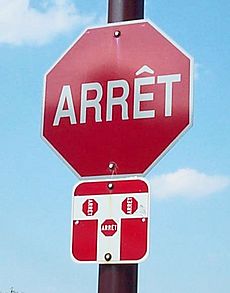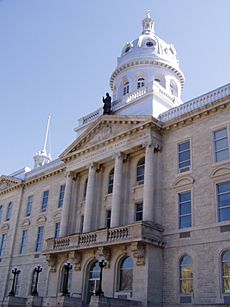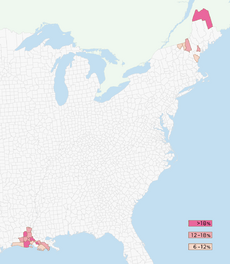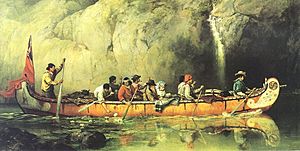French Canadian facts for kids

French Canadians and French Americans as percent of population by state and province
|
|
| Total population | |
|---|---|
| 4,680,820 in Canada (2016 Census) c. 10 million (French-speaking Canadians) 2,100,842 in the United States |
|
| Regions with significant populations | |
| Canada, especially Quebec, New Brunswick, minority in Nova Scotia, Prince Edward Island, Manitoba and Northern and Eastern Ontario, significant minority found in the United States (French Canadian Americans), mostly found in Louisiana, New England, New York and Michigan | |
| Languages | |
| French (Quebec French and Acadian French) and English (Quebec English) | |
| Religion | |
| Predominantly Roman Catholic, minority Protestant (Huguenot) | |
| Related ethnic groups | |
| Quebecois, French, Bretons, Acadians, Cajuns, Métis, Métis in the United States, French Americans, French Canadian Americans, French Haitians, Brayons, Old Stock Canadians |
French Canadians are a group of people whose families came from France to settle in Canada starting in the 1600s. They are also called Franco-Canadians. Today, most French speakers in Canada have French heritage. About 22% of all Canadians speak French.
Most French Canadians live in Quebec, where they are the main group. But you can also find French-speaking communities in all other parts of Canada.
Other French-speaking groups in Canada include the Acadians (from the Maritime Provinces), the Brayons (from New Brunswick), and the Métis (from the Prairie Provinces).
In the 1700s, French-Canadian settlers moved across North America, starting new towns. These settlers mainly came from western France. Today, French Canadians live all over North America.
Between 1840 and 1930, about 900,000 French Canadians moved to the United States. Many settled in the New England area.
Acadians live in the Maritimes. They are often seen as a separate group from French Canadians. This is because their history is different, even though they also speak French.
French Canadians are the second largest cultural group in Canada. They are behind people of English background. However, there is a difference between those who identify as French Canadian and those who simply identify as French. In total, about 11.9 million Canadians have French, French Canadian, Québécois, or Acadian roots. This is about 33.78% of Canada's population.
Not all French-speaking Canadians are of French Canadian descent. Many come from other French-speaking countries like Haiti or Cameroon. Also, not all Canadians with French heritage still speak French today.
Contents
What Does "French Canadian" Mean?
French Canadians get their name from "Canada." This was the most developed part of New France in the 1600s and 1700s. The original "Canada" was the area along the St. Lawrence River. It included Quebec City, Trois-Rivières, and Montreal. It also included the "Pays d'en Haut" (Upper Countries), which covered the Great Lakes area.
From 1535 to the 1690s, the French word "Canadien" referred to the First Nations people. These were the Indigenous groups the French met in the St. Lawrence River valley. By the late 1600s, "Canadien" started to mean people from Canada, not France. After World War II, English-speaking Canadians began using "Canadian" for themselves. French Canadians then started to identify more as Québécois.
French Canadian Identity
French Canadians in Canada use different terms to describe their culture. A 2006 survey found that French-speaking Canadians often identified as French, French Canadian, Québécois, or Acadian. The last three are called "French New World" ancestries. This is because they started in Canada.
The term "Canadien" was used for French-speaking people in New France from the mid-1600s. English-speaking settlers from Great Britain were called "Anglais." This changed after Canadian Confederation in 1867. After that, "Canadian" was used for both English and French speakers across the country.
People who reported "French New World" ancestries often had families in Canada for at least four generations. These groups felt a strong connection to their heritage.
Identity in Quebec
Since the 1960s, French Canadians in Quebec often use "Québécois" (male) or "Québécoise" (female) to describe their identity. They use this instead of "Canadien français." Some francophones who identify as Québécois may not have French-Canadian ancestors. Also, some people with French or French-Canadian roots who support Quebec sovereignty might find "Canadien français" old-fashioned. This shows the strong ties that most Quebecers of French-Canadian origin have to Quebec. The government of Quebec calls all its citizens "Québécois," no matter their language or background.
Identity Elsewhere in Canada
French speakers across Canada may identify as québécois(e), acadien(ne), or Franco-canadien(ne). They might also use names for their provincial groups. These include Franco-manitobain(e) or Franco-ontarien(ne). This is because education, health, and social services are run by provincial groups.
Here are some of these provincial identities:
- Franco-Newfoundlanders (Newfoundland and Labrador)
- Franco-Ontarians (Ontario)
- Franco-Manitobans (Manitoba)
- Fransaskois (Saskatchewan)
- Franco-Albertans (Alberta)
- Franco-Columbians (British Columbia)
- Franco-Yukonnais (Yukon)
- Franco-Ténois (Northwest Territories)
- Franco-Nunavois (Nunavut)
Acadians in New Brunswick, Prince Edward Island, and Nova Scotia have their own distinct French-speaking culture. Their history developed separately from French Canadian culture.
French Canadians outside Quebec are more likely to call themselves "French Canadian." How much they identify with provincial groups changes by province. For example, Franco-Ontarians use their provincial name more often than Franco-Columbians.
Identity in the United States
In the mid-1700s, French Canadian explorers settled other parts of North America. These areas are now Louisiana, Mississippi, Missouri, Illinois, Wisconsin, Indiana, Ohio, northern New York, and Upper Peninsula of Michigan. They founded cities like New Orleans and St. Louis.
Later, many French Canadians moved from Canada to the United States between the 1840s and 1930s. They were looking for jobs. They settled in places like New England. French-Canadian communities still exist along the Quebec border in Maine, Vermont, and New Hampshire. You can also find them further south in Massachusetts, Rhode Island, and Connecticut. Many Catholic churches named after St. Louis in New England show this French immigration. These people came to be known as Franco-Americans.
In the U.S., the differences between French Canadian, French, and other New World French identities are less clear. But those who identify as French Canadian or Franco-American usually do not see themselves as French. They identify with the culture that started in Quebec, which is different from French culture.
Main Franco-American regional identities include:
- French Canadians (e.g., New England French)
- Creoles (e.g., Louisiana Creoles)
- Cajuns
Population Numbers
Today, about 7 million people in Canada and 2.4 million in the United States claim some French-Canadian ancestry. (Another 8.4 million Americans claim French ancestry, but they are counted separately by the U.S. Census Bureau.)
Where French Canadians Live in Canada
In Canada, 85% of French Canadians live in Quebec. They make up most of the population there, except in the far North. Most cities and villages in Quebec were built by the French or French Canadians during colonial times.
There are also many French Canadians in other parts of Canada. This is due to people moving between provinces since the late 1800s. Eastern and Northern Ontario have large French-speaking groups in cities like Ottawa and Sudbury. Many also settled in the Canadian Prairies in the late 1700s. They founded towns like Saint Boniface, Manitoba.

About 70–75% of Quebec's population are descendants of the French pioneers from the 1600s and 1700s.
The table below shows the percentage of people with French ancestry in each Canadian province and territory, based on the 2011 census.
| Province or territory | % | Total population responding |
|---|---|---|
| Canada — Total | 16.07% | 5 380 500 |
| British Columbia | 8.5% | 374 515 |
| Alberta | 11% | 402 070 |
| Saskatchewan | 11.9% | 123 355 |
| Manitoba | 12.3% | 148 805 |
| Ontario | 10.7% | 1 385 200 |
| Quebec | 31.31% | 2 474 025 |
| New Brunswick | 31% | 232 915 |
| Nova Scotia | 18.9% | 174 850 |
| Prince Edward Island | 23.4% | 32 760 |
| Newfoundland and Labrador | 5.5% | 29 355 |
| Nunavut | 1.27% | 405 |
| Northwest Territories | 2.4% | 995 |
| Yukon | 3.69% | 1,250 |
Where French Canadians Live in the United States
Many cities in the United States were founded by French or French-Canadian explorers. These include Mobile, Vincennes, New Orleans, Detroit, and St. Louis.
Most French Canadians in the U.S. live in the New England area. There is also a large group in Plattsburgh, New York. French-Canadian families settled in industrial cities like Fitchburg and Lowell in Massachusetts. They also settled in Woonsocket, Manchester, and Burlington. Smaller groups settled in the Midwest, in states like Michigan and Wisconsin.
Some Metis people still speak Michif. This language is a mix of French and Indigenous languages.
Culture and Traditions
Language

Canadian French is the general name for the different types of French spoken in Canada. These include Quebec French, Acadian French, and Métis French. French Canadians may also speak Canadian English or American English. This is especially true if they live in mostly English-speaking areas.
In Quebec, about six million French Canadians speak French as their first language. About 7.7% of the population speaks English. Others are "Allophones," meaning they speak neither French nor English at home. In the United States, most people of French-Canadian background no longer speak French.
About six million French speakers in Canada live in Quebec. Another one million live across the rest of Canada. Roughly 31% of Canadians speak French. About 25% have French-Canadian roots. Not all French speakers are of French descent. And not all people with French-Canadian heritage speak French.
French speakers outside Quebec have had minority language rights since 1969. This is under the Official Languages Act. New Brunswick officially recognizes French as an official language. Other provinces offer different levels of French services. All three of Canada's territories also have French as an official language.
Religion
Religion in Quebec (2011 National Household Survey): Roman Catholicism (74.7%) Other Christian (7.5%) Non-religious (12.1%) Islam (3.1%) Other (2.6%)
Christianity is the main religion for French Canadians. Most are Roman Catholic. The Kingdom of France did not allow non-Catholics to settle in New France. So, almost all French settlers in Canada were Catholic. In the United States, some French-Canadian families have become Protestant.
Until the 1960s, religion was a very important part of French-Canadian identity. The church parish was the center of community life. Religious groups ran schools, hospitals, and orphanages. They had a big influence on daily life. However, during the Quiet Revolution of the 1960s, fewer people practiced Catholicism. Church attendance in Quebec is now low. Religious practice among French Canadians outside Quebec varies. Generally, those in Quebec are the least religious, while those in the U.S. tend to be more so.
Agriculture
French Canadians have developed special kinds of farm animals over the centuries. These include cattle, horses, and chickens.
Traditionally, French Canadians practiced subsistence agriculture in Quebec. This means they grew food mainly for their own families. This slowly changed into dairy farming in the late 1800s and early 1900s. By 1960, farming became more industrial.
History of French Canadians
The French were the first Europeans to permanently settle in what is now Quebec, parts of Ontario, and other areas of Canada. Their colonies in New France stretched across the Maritime provinces, southern Quebec, Ontario, and the entire Mississippi River Valley.
The first lasting European settlements in Canada were at Port Royal in 1605 and Quebec City in 1608. These were fur trading posts. The areas of New France were Canada, Acadia (later Nova Scotia), and Louisiana. The people in the French colony of Canada called themselves Canadiens. They mostly came from northwestern France. The early settlers of Acadia, or Acadians, mainly came from southwestern France.
French-Canadian explorers and fur traders were known as coureurs des bois and voyageurs. Those who settled on farms were called habitants. Many French Canadians are descendants of the King's Daughters (filles du roi). Many also have mixed French and Algonquian heritage.
In the mid-1700s, French explorers and Canadiens from French Canada settled other parts of North America. These areas are now states like Louisiana, Mississippi, and Illinois. They also settled the Windsor-Detroit region and the Canadian Prairies.

After the British took over New France in 1760 during the Seven Years' War, French Canadians remained important. The British had gained Acadia in 1713. In 1774, the Quebec Act allowed French Canadians to use their French civil law system again. In 1791, French Canadians in Lower Canada got an elected Legislative Assembly.
However, this assembly had little power. This led to the Lower Canada Rebellions in 1837–1838. After this, Lower Canada and Upper Canada were joined together. One reason for this union was to reduce French-Canadian political power.
Over the late 1800s and 1900s, French Canadians became unhappy with their place in Canada. This was due to events like the execution of Louis Riel. Also, French-language schools were banned in Ontario (Regulation 17). Canada's involvement in wars and conscription crises also caused problems.
Between the 1840s and 1930s, about 900,000 French Canadians moved to the New England region. About half of them later returned home. The generations born in the United States eventually saw themselves as Franco-Americans. During the same time, many French Canadians also moved to Eastern and Northern Ontario. Their descendants make up most of today's Franco-Ontarian community.
Since 1968, French has been one of Canada's two official languages. It is the only official language of Quebec. It is also an official language in New Brunswick, Yukon, the Northwest Territories, and Nunavut. Ontario does not have official languages defined by law. However, its government provides French language services in many areas.
Modern Use of the Term
In English, terms for provincial groups (like "Franco-Ontarian") are often used interchangeably with "French Canadian." But many French Canadians, especially in Quebec, find this outdated. Most French-speaking Canadians use their province of origin to identify themselves. For example, a Québécois who moves to Manitoba would still call themselves Québécois.
Provincial labels are increasingly used to highlight the language and culture of French-speaking groups. This is different from their ethnic or religious background. The term "French Canadian" is still used for historical and cultural topics. It is also used when talking about all Canadians of French-Canadian heritage together. French-speaking Canadians who are not of French-Canadian origin (like immigrants) are usually called "francophones."
French-Canadian Flags
Images for kids
See also
 In Spanish: Francocanadienses para niños
In Spanish: Francocanadienses para niños




















